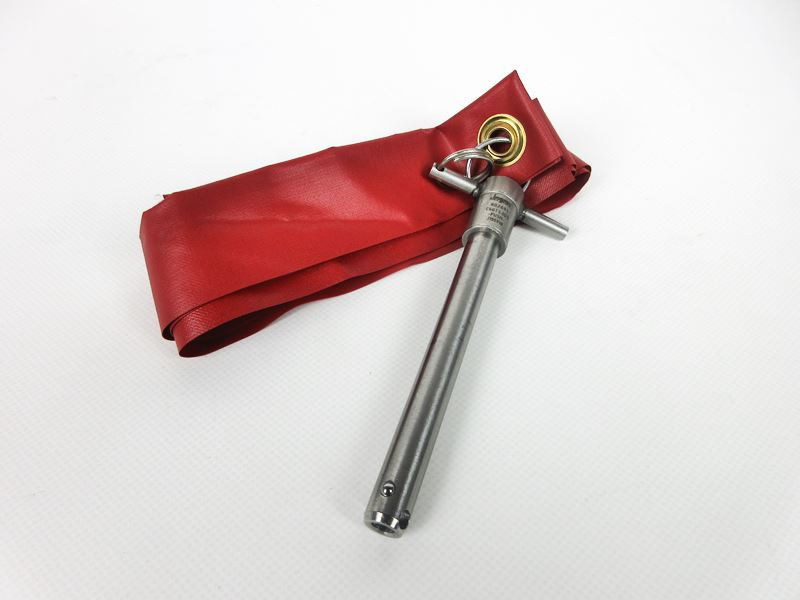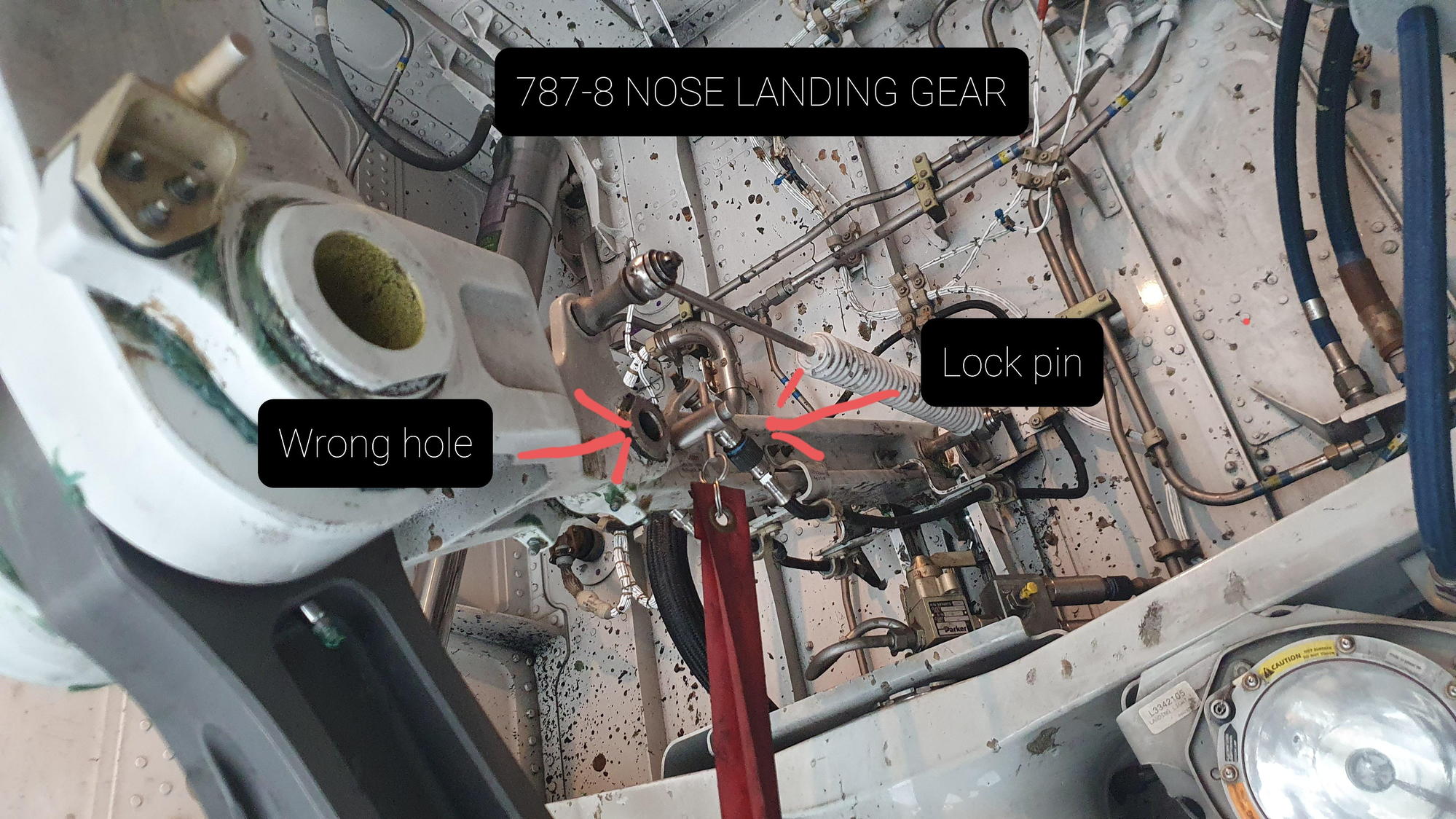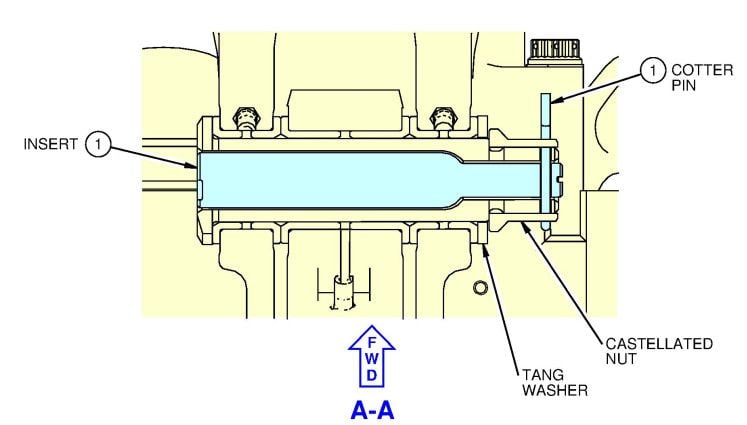BA 787 Nosewheel collapse @ LHR
Yes, but it can be overridden for the purposes of function checks. Hence why steel ground lock pins are fitted to prevent the gear from moving.
In all of 40+ years in maintenance I have put a parked aircraft in air mode perhaps as many times, the electronic wizards nearly daily for auto pilot checks with hydraulics on, older airframes, but if I had anything to do with it I preferred with a tug and tow bar attached and all gears pinned and chocked, but none of these required the gear selected up!
Used the lock solenoid over-ride button on the gear selector panel, perhaps 20 times mostly for unlock indication faults, again hydraulics not needed.
Aircraft are routinely pushed back and towed with only the steering lock-out pin fitted; though I recall on B727's incidents when this was not enough to stop a tow bar shear pin event, if the FE selected hydraulics or started engine motoring; so it begs the question if this was a maintenance caused incident:- what was going on?
Used the lock solenoid over-ride button on the gear selector panel, perhaps 20 times mostly for unlock indication faults, again hydraulics not needed.
Aircraft are routinely pushed back and towed with only the steering lock-out pin fitted; though I recall on B727's incidents when this was not enough to stop a tow bar shear pin event, if the FE selected hydraulics or started engine motoring; so it begs the question if this was a maintenance caused incident:- what was going on?
As a matter of interest, how do gear lock pins work?
Do they operate an electric switch; preventing fluid flow? Do they operate an hydraulic valve; preventing fluid flow? Do they prevent movement of a side stay, which in turn prevents hydraulic pressure being applied to the main jacks?* Or do they physically withstand the full force of 3000psi hydraulic pressure?
*Airbus A320 main gear locks consist of a sleeve which prevents retraction of a side-stay ram. So they must withstand full hydraulic force. The nose gear is a pin, if I recall.
Do they operate an electric switch; preventing fluid flow? Do they operate an hydraulic valve; preventing fluid flow? Do they prevent movement of a side stay, which in turn prevents hydraulic pressure being applied to the main jacks?* Or do they physically withstand the full force of 3000psi hydraulic pressure?
*Airbus A320 main gear locks consist of a sleeve which prevents retraction of a side-stay ram. So they must withstand full hydraulic force. The nose gear is a pin, if I recall.
So... there is a hydraulic valve kept shut until the side stay moves? By locking the side stay - which presumably has much less pressure fed to it - a small pin can prevent activation of the main jack?
The Lock pins physically prevent the side brace/drag brace from moving. The side/drag brace forms a geometric lock that prevents the gear collapsing even without hydraulic pressure applied. The A320 uses sleeves around the down lock actuator that prevents the side stay from moving.
When the gear is selected 'up' on the ground, hydraulic pressure is still applied to the actuators but they are prevented from moving by the pins and/or sleeves.
When the gear is selected 'up' on the ground, hydraulic pressure is still applied to the actuators but they are prevented from moving by the pins and/or sleeves.
Uplinker
"Do they operate an electric switch; preventing fluid flow? Do they operate an hydraulic valve; preventing fluid flow? Do they prevent movement of a side stay, which in turn prevents hydraulic pressure being applied to the main jacks?* Or do they physically withstand the full force of 3000psi hydraulic pressure."
None of the above.
See the response in post #63 to the previous poster who asked the same question.
"Do they operate an electric switch; preventing fluid flow? Do they operate an hydraulic valve; preventing fluid flow? Do they prevent movement of a side stay, which in turn prevents hydraulic pressure being applied to the main jacks?* Or do they physically withstand the full force of 3000psi hydraulic pressure."
None of the above.
See the response in post #63 to the previous poster who asked the same question.
Join Date: Feb 2008
Location: Apple Maggot Quarantine Area
Age: 47
Posts: 100
Likes: 0
Received 0 Likes
on
0 Posts
It was mentioned earlier in the thread, but to prevent rehashing the issue, the hollow pivot bolt necks down internally and can accept the lockpin fairly snugly.
But - the 777 has this exact same configuration, with a hollow pivot bolt right next to the lockpin location. (Sorry, can't find a good photo online.) I'm curious why this has not been an enough of an endemic issue on the 777 to issue an AD. There have certainly been inadvertent 777 nose gear retractions that you can find on Google.
But - the 777 has this exact same configuration, with a hollow pivot bolt right next to the lockpin location. (Sorry, can't find a good photo online.) I'm curious why this has not been an enough of an endemic issue on the 777 to issue an AD. There have certainly been inadvertent 777 nose gear retractions that you can find on Google.
Last edited by slacktide; 24th Jun 2021 at 23:21.
slacktide
"It was mentioned earlier in the thread, but to prevent rehashing the issue, the hollow pivot bolt necks down internally and can accept the lockpin fairly snugly.
But - the 777 has this exact same configuration, with a hollow pivot bolt right next to the lockpin location. (Sorry, can't find a good photo online.) I'm curious why this has not been an enough of an endemic issue on the 777 to issue an AD. There have certainly been inadvertent 777 nose gear retractions that you can find on Google."
The gear pin is a bog-standard pip pin that any engineer from the last 50 years or more would recognise. It is indeed the same part number for the 777 and 787:

Judging from the photo of the nose bay, I suspect that a "snug fit" inside the (larger diameter) pivot bolt would only occur if the pin were inserted up to and including the shoulder.
It would (should?) then be obvious to the user that the pips were not engaged with anything and that the pin could be pulled out without having to depress the button to release it.
While I agree that it's not 100.00% Murphy-proof, any engineer or ground handler who doesn't understand something so basic is in the wrong job.
(with the caveat that the "pin in the wrong hole" scenario just a theory so far and has yet to be confirmed by the AAIB)
"It was mentioned earlier in the thread, but to prevent rehashing the issue, the hollow pivot bolt necks down internally and can accept the lockpin fairly snugly.
But - the 777 has this exact same configuration, with a hollow pivot bolt right next to the lockpin location. (Sorry, can't find a good photo online.) I'm curious why this has not been an enough of an endemic issue on the 777 to issue an AD. There have certainly been inadvertent 777 nose gear retractions that you can find on Google."
The gear pin is a bog-standard pip pin that any engineer from the last 50 years or more would recognise. It is indeed the same part number for the 777 and 787:

Judging from the photo of the nose bay, I suspect that a "snug fit" inside the (larger diameter) pivot bolt would only occur if the pin were inserted up to and including the shoulder.
It would (should?) then be obvious to the user that the pips were not engaged with anything and that the pin could be pulled out without having to depress the button to release it.
While I agree that it's not 100.00% Murphy-proof, any engineer or ground handler who doesn't understand something so basic is in the wrong job.
(with the caveat that the "pin in the wrong hole" scenario just a theory so far and has yet to be confirmed by the AAIB)

A modified version.
Join Date: Apr 2019
Location: EDSP
Posts: 334
Likes: 0
Received 0 Likes
on
0 Posts
Being a fan of that Murphy guy:
- The upside of the RBF flag on this pin is: it lowers the chance of going airborne with a pin locking down the gear.
- The downside of it is: a cursory look will confirm that a pin is in place, when it is in fact in the hole next door, and above happens.
Doing a traffic circuit with gear locked down might be the cheaper option .
.
- The upside of the RBF flag on this pin is: it lowers the chance of going airborne with a pin locking down the gear.
- The downside of it is: a cursory look will confirm that a pin is in place, when it is in fact in the hole next door, and above happens.
Doing a traffic circuit with gear locked down might be the cheaper option
 .
.
Question from the peanut gallery
How much leeway is there in pinning/unpinning landing gear between operators? Might some pin the gear only when necessary (towing, maintenance) and others pin the gear and leave it until pushback and uncoupling the tug?
How might this situation be exacerbated by new hiring to fill vacancies created by Covid?
How might this situation be exacerbated by new hiring to fill vacancies created by Covid?
Join Date: Dec 2000
Location: Horsham, England, UK. ---o--O--o---
Posts: 1,185
Received 4 Likes
on
2 Posts
I have to say, the incorrect reinforced looking hole does look like it should be the one to be used. The correct one looks quite insignificant in comparison! I can’t believe that it was not marked properly. Very poor engineering from Boeing…. 🤭
Join Date: Dec 2016
Location: Small aprtment
Posts: 45
Likes: 0
Received 0 Likes
on
0 Posts
BDAttitude
Yes. But a 788 departing at max weight still has to burn off/dump 55 tonnes before it's light enough to land. (77W about 100 tonnes)
so it's a pretty big circuit!
Yes. But a 788 departing at max weight still has to burn off/dump 55 tonnes before it's light enough to land. (77W about 100 tonnes)
so it's a pretty big circuit!
EEngr
From my experience the pins are only used for maintenance tests as required or for long term parking. Even towing between stands these days seems to be operator choice. Some insist, some just want the nose pin, some directly mandate that they're not used for towing at all to avoid any unpleastness. The risk of them being left in out ways the risk of a gear collapse during towing.
If you are only ever working with one operator then there is no real excuse for not knowing their procedure. If you are working multiple airlines and aircraft types then it is more likely that an incorrect procedure could be used.
From my experience the pins are only used for maintenance tests as required or for long term parking. Even towing between stands these days seems to be operator choice. Some insist, some just want the nose pin, some directly mandate that they're not used for towing at all to avoid any unpleastness. The risk of them being left in out ways the risk of a gear collapse during towing.
If you are only ever working with one operator then there is no real excuse for not knowing their procedure. If you are working multiple airlines and aircraft types then it is more likely that an incorrect procedure could be used.





